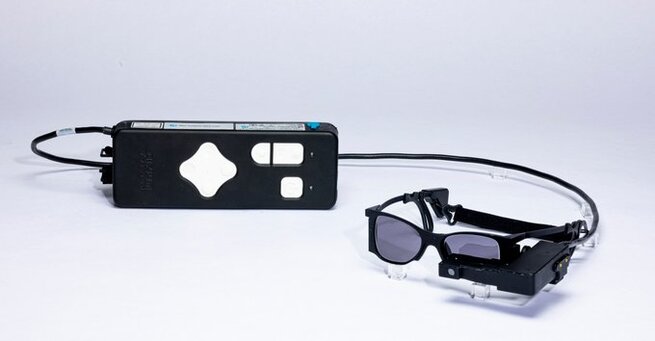Alerts

A breakthrough study has shown that blind patients read again with smart glasses-linked eye implant technology, restoring partial sight to people with severe vision loss. About 80 percent of participants with “profound” age-related macular degeneration (AMD) reported improved vision after using the implant and specialized smart glasses system.
Researchers from Science Corporation and The New England Journal of Medicine revealed that patients regained enough central vision to read books and complete crossword puzzles. The participants, all aged 60 and above, had advanced AMD in both eyes — a condition previously considered irreversible.
The innovation combines smart glasses with a retinal implant to restore some vision. The 2-by-2-millimeter implant, made of miniature photovoltaic solar panels, is surgically inserted under the retina.
When patients wear the camera-equipped smart glasses, they transmit infrared images to the implant. These images are then converted into small electrical pulses that stimulate the optic nerve, mimicking how healthy retinal cells send visual signals to the brain.
The clinical trial began with 38 participants, with 32 completing the one-year study. By the end of the trial, 26 patients experienced significant vision improvement, meaning 80 percent regained partial sight.
Although the restored vision is limited to black and white and somewhat blurry, researchers describe the results as “remarkable progress.” Patients could once again identify objects, read printed text, and navigate more independently.
Age-related macular degeneration (AMD) remains one of the leading causes of blindness in older adults. The disease destroys cells in the retina’s center, making it impossible to focus clearly. Until now, treatment options could only slow progression — not restore lost vision.
This new smart glasses-linked eye implant represents a revolutionary leap forward, offering renewed hope for millions living with advanced AMD.
The eye implant system was developed by Science Corporation, a brain-computer interface company founded by Max Hodak, who also co-founded Neuralink alongside Elon Musk in 2016. Science Corporation acquired the implant technology from Pixium Vision, a French medical device company that had been developing similar tech for nearly a decade before financial difficulties halted its progress.
This partnership brought together neural engineering and biomedical innovation, paving the way for one of the most promising breakthroughs in visual prosthetics.
Experts unaffiliated with the study called the progress “amazing” and believe this could be the foundation for future full-color and high-resolution sight restoration. Continued clinical trials are expected to improve the implant’s capabilities and durability, with potential integration into broader medical use within the next few years.
Science Corporation is reportedly refining both the glasses’ image sensors and the implant’s response system to deliver sharper, more natural visuals for users.
Following the success of the current study, more trials are planned to explore how AI-powered enhancements can make the system even smarter — including real-time object recognition and depth perception assistance.
As researchers continue to enhance the smart glasses-linked eye implant, the dream of restoring meaningful sight to the blind edges closer to reality. The fusion of wearable tech and neural science could redefine how society approaches blindness and visual disabilities.
𝗦𝗲𝗺𝗮𝘀𝗼𝗰𝗶𝗮𝗹 𝗶𝘀 𝘄𝗵𝗲𝗿𝗲 𝗿𝗲𝗮𝗹 𝗽𝗲𝗼𝗽𝗹𝗲 𝗰𝗼𝗻𝗻𝗲𝗰𝘁, 𝗴𝗿𝗼𝘄, 𝗮𝗻𝗱 𝗯𝗲𝗹𝗼𝗻𝗴. We’re more than just a social platform — from jobs and blogs to events and daily chats, we bring people and ideas together in one simple, meaningful space.
